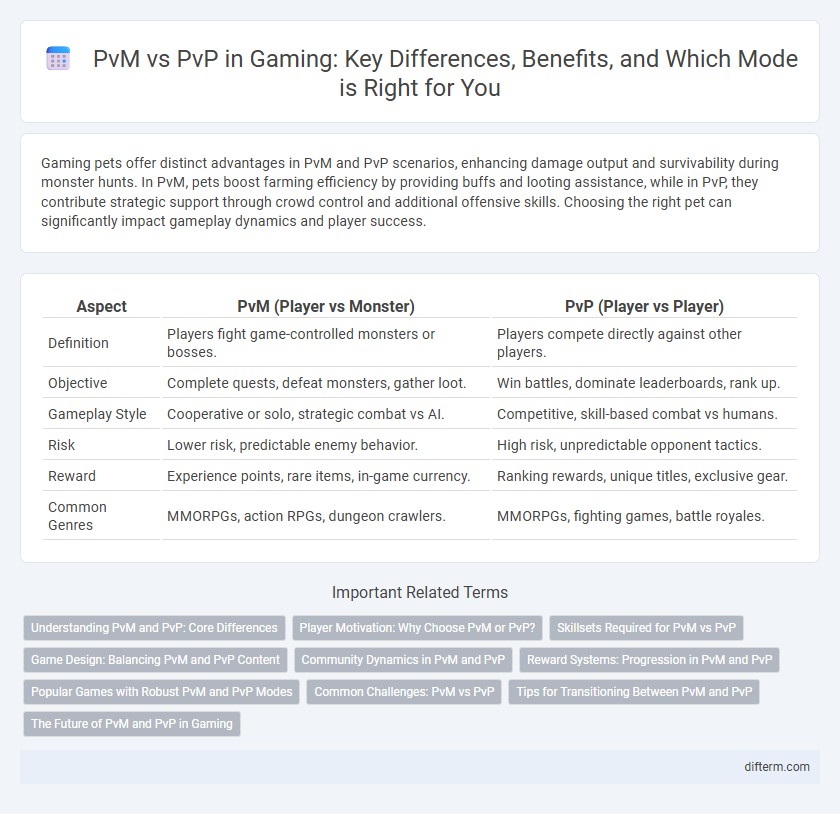Gaming pets offer distinct advantages in PvM and PvP scenarios, enhancing damage output and survivability during monster hunts. In PvM, pets boost farming efficiency by providing buffs and looting assistance, while in PvP, they contribute strategic support through crowd control and additional offensive skills. Choosing the right pet can significantly impact gameplay dynamics and player success.
Table of Comparison
| Aspect | PvM (Player vs Monster) | PvP (Player vs Player) |
|---|---|---|
| Definition | Players fight game-controlled monsters or bosses. | Players compete directly against other players. |
| Objective | Complete quests, defeat monsters, gather loot. | Win battles, dominate leaderboards, rank up. |
| Gameplay Style | Cooperative or solo, strategic combat vs AI. | Competitive, skill-based combat vs humans. |
| Risk | Lower risk, predictable enemy behavior. | High risk, unpredictable opponent tactics. |
| Reward | Experience points, rare items, in-game currency. | Ranking rewards, unique titles, exclusive gear. |
| Common Genres | MMORPGs, action RPGs, dungeon crawlers. | MMORPGs, fighting games, battle royales. |
Understanding PvM and PvP: Core Differences
PvM (Player versus Monster) emphasizes cooperative gameplay where players team up to defeat AI-controlled enemies, focusing on strategy, resource management, and progression through quests or dungeons. PvP (Player versus Player) centers on competitive encounters between players, testing skills, reflexes, and tactics in real-time combat scenarios. Understanding the core differences between PvM and PvP involves recognizing PvM's focus on PvE challenges and teamwork, while PvP prioritizes player skill, adaptability, and direct conflict.
Player Motivation: Why Choose PvM or PvP?
Player Motivation in Gaming often hinges on preference for PvM (Player versus Monster) or PvP (Player versus Player) experiences. PvM appeals to gamers seeking cooperative gameplay, strategic combat against AI-controlled enemies, and progression through quests or raids. PvP attracts those driven by competition, skill mastery, real-time challenges against human opponents, and the thrill of ranking up in leaderboards.
Skillsets Required for PvM vs PvP
PvM (Player versus Monster) requires strategic planning, crowd control, and efficient use of resources to manage multiple enemies and optimize damage output. PvP (Player versus Player) demands advanced reflexes, prediction of opponent moves, and adaptability to diverse playstyles for effective combat. Mastery in PvP often includes quick decision-making and knowledge of game mechanics, while PvM emphasizes endurance and team coordination.
Game Design: Balancing PvM and PvP Content
Effective game design carefully balances PvM (Player versus Monster) and PvP (Player versus Player) content to create diverse and engaging gameplay experiences. PvM challenges often emphasize strategic planning and progression through AI-controlled enemies, while PvP requires finely tuned mechanics to ensure fair competition and player skill emphasis. Balancing these elements involves adjusting difficulty, rewards, and matchmaking systems to cater to varying player preferences and maintain long-term engagement.
Community Dynamics in PvM and PvP
PvM fosters cooperative community dynamics where players collaborate to defeat AI-controlled enemies, encouraging teamwork and shared strategies. PvP generates competitive interactions, driving rivalry and social tension that can strengthen player bonds through conflict or lead to community fragmentation. Both modes shape distinct player behaviors and social structures within the gaming ecosystem.
Reward Systems: Progression in PvM and PvP
PvM reward systems often emphasize progression through experience points, loot drops, and skill enhancements that enable players to tackle increasingly difficult challenges and boss encounters. PvP rewards prioritize rankings, seasonal rewards, and unique cosmetic items that reflect a player's skill and competitive achievements against others. Both modes incentivize consistent play but cater to different motivations: steady character growth in PvM versus competitive recognition and status in PvP.
Popular Games with Robust PvM and PvP Modes
Popular games like World of Warcraft and Final Fantasy XIV feature robust PvM experiences through challenging raids and dungeons alongside competitive PvP arenas and battlegrounds, catering to diverse player preferences. Guild Wars 2 offers expansive open-world PvM content while maintaining dynamic structured PvP modes that emphasize skill and strategy. Destiny 2 balances engaging PvM strikes and raids with thrilling PvP Crucible matches, attracting a wide community of gamers seeking both cooperative and competitive gameplay.
Common Challenges: PvM vs PvP
PvM (Player versus Monster) often challenges players with predictable enemy patterns and resource management, while PvP (Player versus Player) demands quick adaptability to unpredictable human tactics and strategies. Balancing gear optimization and skill usage is critical in PvM to efficiently defeat AI opponents, whereas in PvP, mastering situational awareness and counterplay against diverse player behaviors is essential. Both modes require different mental preparations: PvM emphasizes endurance and strategy repetition, PvP prioritizes reflexes and psychological warfare.
Tips for Transitioning Between PvM and PvP
Mastering the transition between PvM (Player versus Monster) and PvP (Player versus Player) requires adapting your strategy and gear to each mode's demands. Prioritize building versatile skill sets, balancing offensive capabilities in PvM with defensive tactics crucial for PvP encounters. Optimize loadouts with a mix of survivability items and high-impact weapons to seamlessly switch between battling AI-controlled monsters and hostile players.
The Future of PvM and PvP in Gaming
The future of PvM and PvP in gaming is marked by advanced AI integration and immersive technologies like VR and AR, enhancing player interaction and strategic depth. Procedural content generation and real-time physics create dynamic environments, making PvM encounters more unpredictable while PvP battles become increasingly skill-based and competitive. Cross-platform play and cloud gaming further expand accessibility, fostering larger, more diverse gaming communities.
PvM vs PvP Infographic

 difterm.com
difterm.com